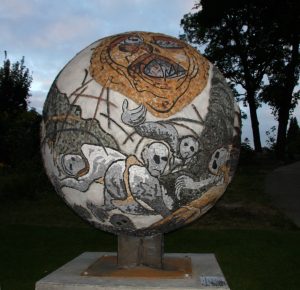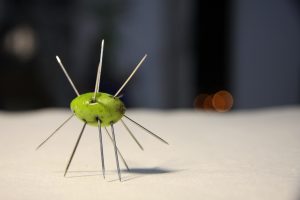Rana Bishara is a Palestinian installation artist, painter, graphic artist, photographer, performing artist, and sculptor. Born (in 1971) and raised in the village of Tarshiha in the Galilee in northern Palestine, she received a bachelor’s degree in fine arts, women’s studies, and philosophy from Haifa University in 1993 and completed a master’s in fine arts on a Fulbright Scholarship at the Savannah College of Art and Design in 2003.
Human rights and the Palestinian cause are the major themes in Rana’s art. Her motives and symbols are connected to the memory, identity, and heritage of Palestine and convey the complexity of the political situation. To express personal and political issues, she develops actions and artifacts around Palestinian themes to connote issues of durability, fragility, and ubiquity.
Rana’s artwork is both poetic and literal. Her sculptural installations, paintings, and recent performance pieces express, through a very personal voice, her attachment to and love for the land she inhabits and her profound frustration with and rage against the ongoing occupation of Palestine and the oppression of Palestinians. Rana’s work functions simultaneously as an elegy for the Palestinian Nakba (disaster), an unmasking of the brutality of the Israeli occupation of Palestine, and a critique of the biased Western media’s depiction of the Palestinians’ struggle against their occupiers.

(steel, concrete and mosaic, 4.5 x 4×4 meters.)
Parc du Château de l’Étang, Bagnolet, France.
Rana’s conceptual approach is diverse. Some of her projects employ relatively confrontational and overt depictions of the brutality and humiliations inflicted upon the Palestinians by the occupying forces. Other projects develop subtle and frequently enigmatic metaphors that visually and emotionally seduce the viewers to contemplate the strength, tenderness, resilience, and passions of her people. Her choice of materials ranges from conventional sculptural elements such as wood, glass, and steel to common utilitarian elements such as chocolate, cactus, zaatar (thyme), bread, and balloons that perform as surrogates for the body and spirit of Palestine and its people. Her work, in both its physical and conceptual manifestations, is an expression of the inseparable blending of the personal and political experiences that define the identity of most Palestinians.*

Rana’s artwork has been exhibited in solo and group shows in Palestine, Morocco, Jordan, France, Switzerland, the Netherlands, the United Kingdom, Scandinavia, Austria, Norway, Sweden, Dubai, Poland, Germany, Canada, and in various states in the United States. She has participated in many art residencies and talks such as AXENÉO7− Gatineau, Quebec, Canada; A Space Gallery, Toronto, Canada; Art/Omi − New York; Darat Al Funun, Amman, Jordan; and in Morocco and France. Her works can be found in private collections, galleries, and museums that include the National Gallery of Fine Arts and Darat Al-Funun in Amman, Jordan; Art/Omi International Arts Center, New York; and the Savannah College of Art and Design.
Rana has curated and exhibited important shows that revolve around the Palestinian cause and Palestinian children, including UNRWA’s “Homage to Childhood – December 2008.” She launched the celebratory events of UNRWA @ 60, and after the 2008–2009 war on Gaza, she curated and exhibited a show on the occasion of the WHO’s “World Health Day 2009 – Save Lives. Make hospitals safe in emergencies.” In 2012, Rana designed and created a monument for Sabra and Shatila’s 30th anniversary in the Parc du Château de l’Étang, Bagnolet, France. Between 2009 and 2011, she headed the art department at Al-Quds University in Jerusalem.
Rana currently lives and works between Tarshiha and Beit Jala as a freelance artist and art instructor at Dar Al Kalima University College of Arts and Culture in Bethlehem, Palestine.

“During the last decades, the urgency of the violent situation in Palestine has compelled me to shift from museum and gallery walls to performance art that involves a direct engagement with the public during street protests. The need to be with people in the public space, in courtrooms, and in hospitals has liberated my work from the burden of the classic art form.”
For a detailed analysis of some of Rana’s artwork, see John Halaka, “Outsiders on the Inside,” Nebula, 2008.

